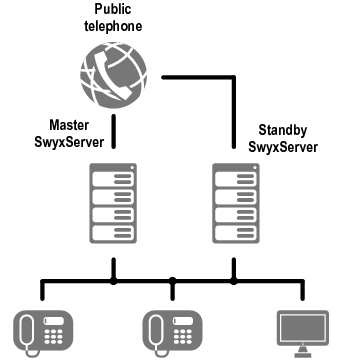Standby-SwyxServer
Installation of a second SwyxServer in order to guarantee improved availability of the phone system
The option pack SwyxStandby offers enhanced availability of the SwyxWare PBX through the use of a second redundant SwyxServer installed on a further Windows server, which acts as a standby server.
Fig. 20-1: Master and Standby Scenario, SwyxServer
In this scenario, a standby SwyxServer is installed on a further computer to take over the tasks of the master SwyxServer in the event of a breakdown. All settings of the master SwyxServer are continuously mirrored on the standby SwyxServer . One of the two servers is active, there the telephony clients ( and ) log on. This server manages the establishing of the calls and the scripts of the users are running on this server. The other -passive- server updates continuously the associated database, but the telephony client couldn't log on at this server. If the active SwyxServer failes (crash, network problems), the passive SwyxServer automatically takes over the function of the failed SwyxServer after a short time.
In addition to the automatic breakdown protection, it is naturally also possible to switch manually between the two systems at any time, e.g. for maintenance.
Differences between Master and Standby Server
It is specified during installation whether the installed server should be a master or a standby server. These terms must not be confused with the state of a server: active or passive. The differences between master and standby servers are in the following points:

Database replication
If SwyxWare is installed or updated, the standby server's database is overwritten with the contents of the master server's database. The replication that takes place during operation between the two servers is bidirectional. This means that a change in the one system is transferred in the short term to the other system. If an entry is simultaneously changed in both systems, the entry in the master system is given preference.

Change of state: active/passive (manual switch)
It is not possible to make a switch if the SwyxWare Administration connects to the standby server.

Licenses
SwyxWare licenses can only be input on a master system; they are replicated to the standby system afterwards. They become invalid if no connection to the master system can be set up for longer than 28 days.

Conflict of states
If both systems are simultaneously passive (e.g. because both servers are being started at the same time) or both are simultaneously active (e.g. after a network outage between the two systems), then the master server becomes the active system and the standby server the passive one.
| If maintenance work has to be carried out on one server, please switch state manually to make this server passive. If the network connection between the two systems is interrupted, then both systems will become active on the assumption that the other one has failed. When the network connection is subsequently restored, the master system becomes active and the standby system passive. Current changes to the standby system database are transferred at this time. |
Supervision Mechanism
The two SwyxServers are connected to each other via a TCP connection, and exchange a message every second.
If the passive system receives no further messages or the TCP connection is interrupted, the passive system becomes active within a short time.
Restart Action
All systems start in the passive state. If no other SwyxServer is detected after the start, then the newly started server automatically becomes active. If another system which is already active is detected, the passive state is preserved. If another server is detected which is likewise passive (e.g. after a simultaneous restart), then the master server becomes active and the standby server remains passive.
1 * This function is not available for SwyxWare for DataCenter.

